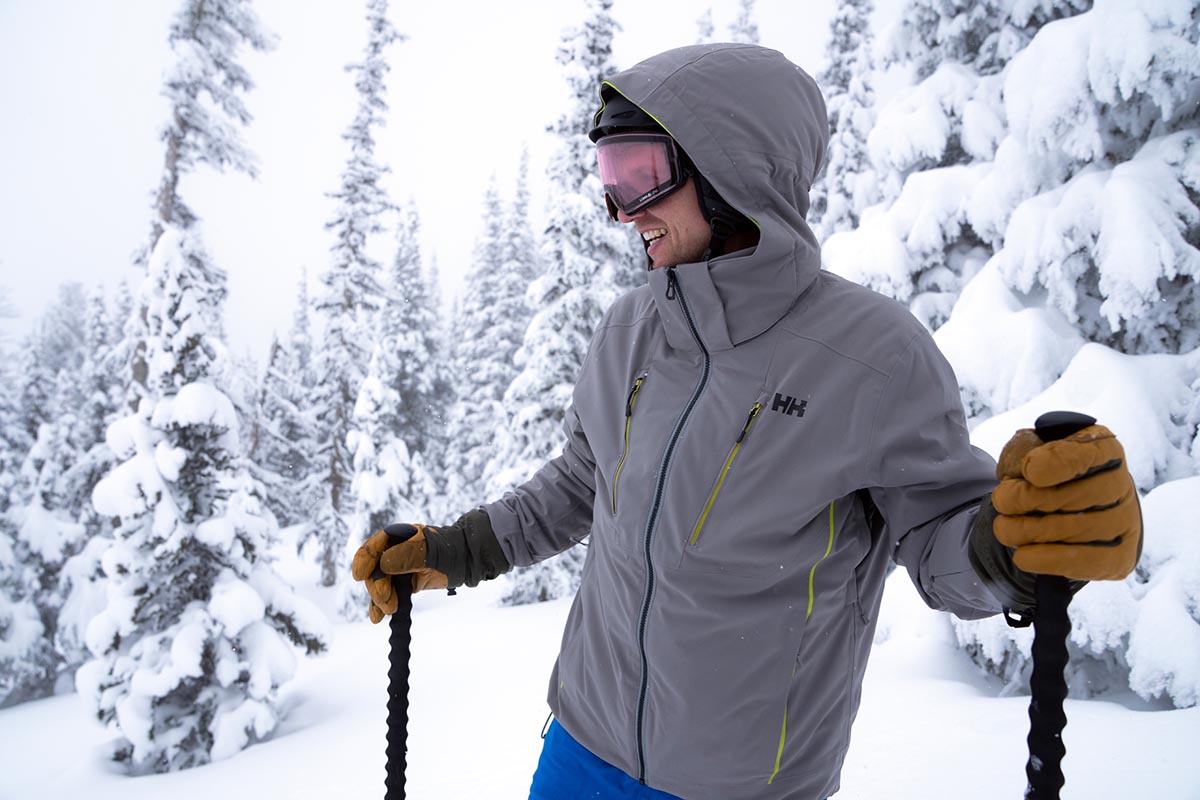
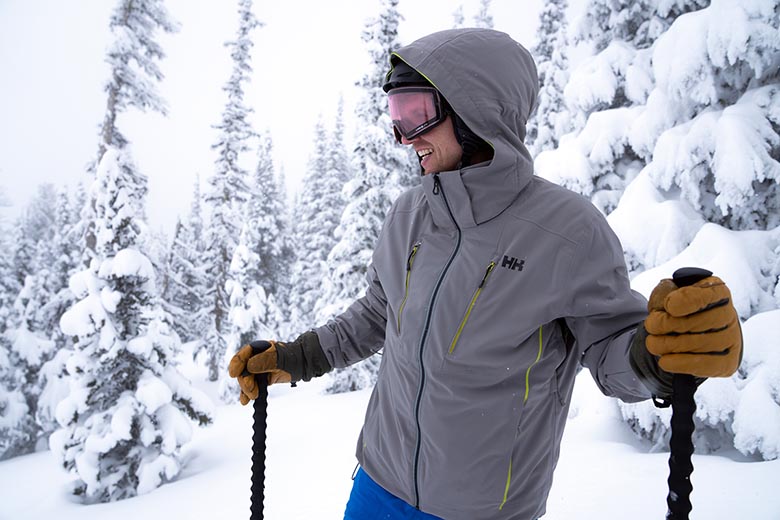
Price: $475
Waterproofing: 2L Helly Tech Professional
Insulation: 80g PrimaLoft Black Eco
What we like: Standout comfort with a stretchy shell and soft lining, reliable protection, and just-right warmth for season-long use.
What we don't: Relatively short back length; so-so adjustability on the hood.
See the Men's Helly Hansen Alpha 4.0
Helly Hansen’s Alpha has been our top-rated resort ski jacket for years, and the new-for-winter-2024 “4.0” carries the torch. This popular ski jacket has a great fit and feel with its stretchy construction and hits a real sweet spot in warmth, features, comfort, and protection for season-long resort use. We put the latest model to the test and had very few quibbles. Some may prefer a longer cut, and the hood is a little hard to fully cinch down in rowdy conditions, but otherwise it’s everything we look for in a downhill ski jacket—at a relatively reasonable price to boot. Below we break down our experiences with the Alpha 4.0. To see how it stacks up to the competition, check out our article on the best ski jackets.
Editor’s note: Due to sizing availability at the time of our photoshoot, the pictures in this article are of a men’s size large jacket, which was too big for our tester. We were able to get a men’s medium for testing, however, and the information below reflects our experience with the appropriate size.
Similar to our experiences with the prior generations, Helly Hansen’s latest Alpha 4.0 offers stalwart protection with in-house 2-layer waterproofing, full seam sealing, and an all-around quality build. I was faced with the full gamut of conditions during testing, from deep powder to early-season heavy rain and wind, and the jacket handled it all flawlessly. In light moisture, the durable water repellent (DWR) coating effectively beaded up rain and snow, and the membrane kept me dry and comfortable even when the exterior was overwhelmed with drenching rain. Wind protection was similarly impressive: My local resort is known for high winds at the summit, and even while waiting out a mechanical delay on the lift in those signature gusty conditions, my upper body remained fully isolated thanks to the windproof shell and cozy layer of insulation. There aren’t a lot of brands that we put on par with Gore-Tex in terms of reliability, but Helly Hansen’s Helly Tech Professional membrane has continually impressed us.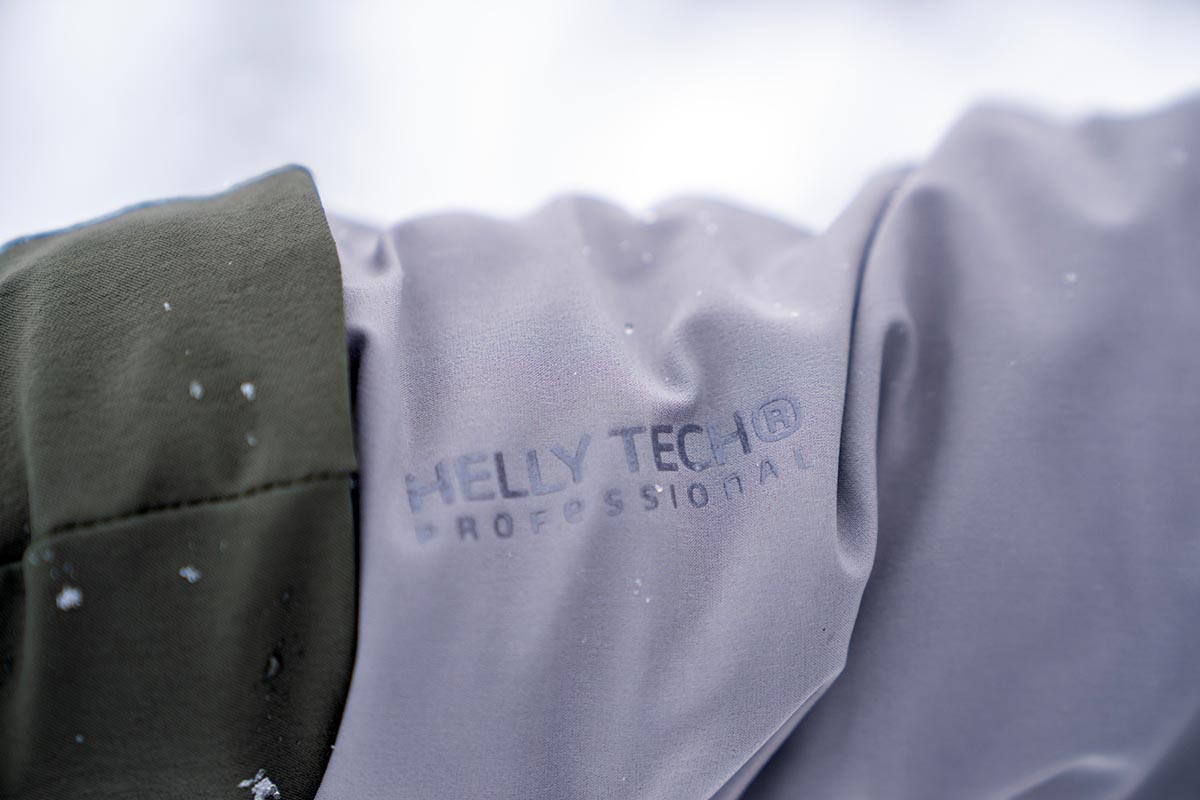
Rounding out the protective features, the Alpha includes a premium and smooth-operating water-resistant main zipper, and its tall collar completely covers the neck all the way up to my bottom lip. As expected, you can further seal out the cold and wet with a powder skirt, two cinches at the waist (one on each side), and adjustable cuffs that fit nicely both under gauntlet gloves and over the top of undercuff designs. You also get three adjustment points for the helmet-compatible hood, although it’s a little tedious to fully batten down the hatches (more on this below). Additionally, some may prefer a longer cut for maximum protection—the Alpha isn’t quite long enough to fully cover your backside when sitting on a chairlift. But otherwise, it proved to be highly reliable and truly storm-worthy in classic Pacific Northwest conditions.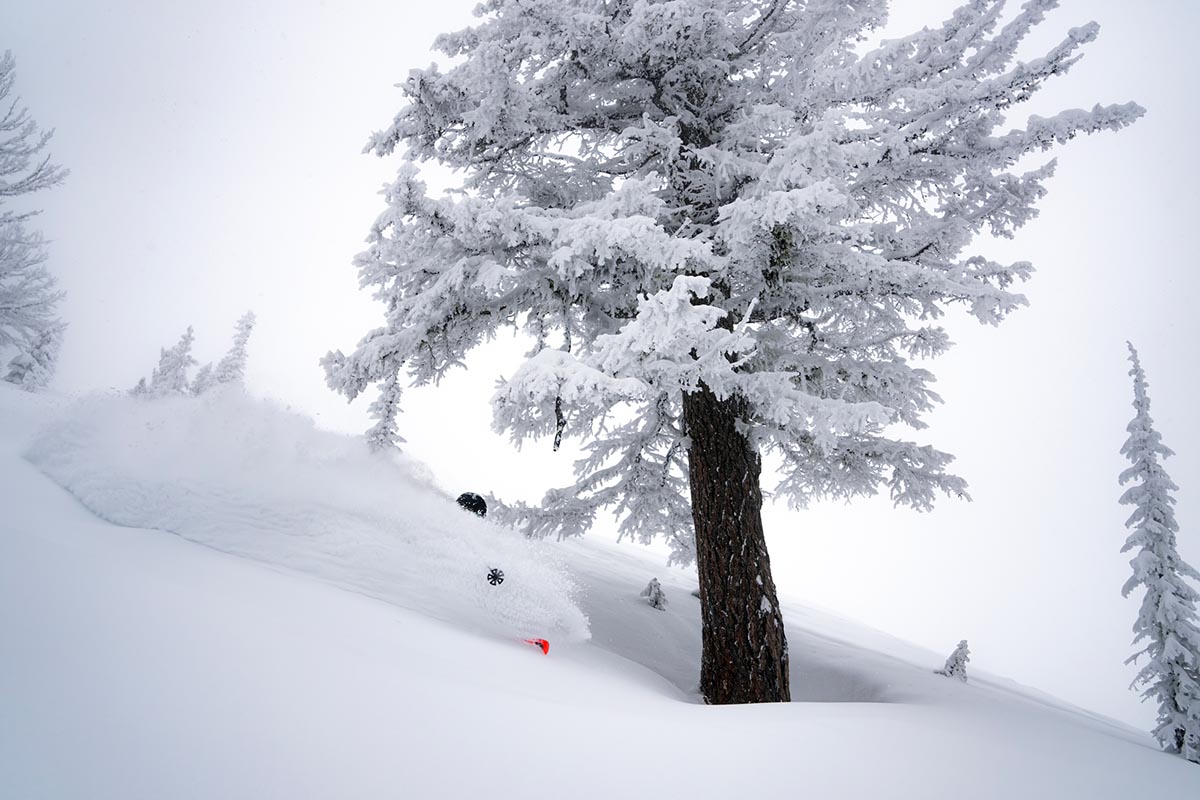
I typically prefer uninsulated ski jackets for their versatility, but it’s hard to knock the Alpha’s balanced level of warmth for season-long use. Featuring high-end 80-gram (g) PrimaLoft Black Eco and the aforementioned windproof construction, the jacket kept me comfortable lapping groomers with just a midweight baselayer underneath (I also wore a mid-height bib) in temperatures down to the low 20s Fahrenheit. Importantly, it’s not overly insulated to create issues on mild-weather days, and Helly Hansen came up with some creative solutions to maximize breathability (which we outline below). Further, the stretchy build and fairly athletic fit leave just enough room to add a midlayer should temperatures drop—a midweight fleece was the most I needed for days that dipped into the low teens and single digits. All told, the lofty synthetic fill does its job while keeping weight and bulk to a minimum.
Insulated ski jackets prioritize warmth over breathability, and we rarely recommend them for those who spend a lot of time exploring off trail. As expected, I heated up even on relatively short (10-15 min.) hikes to access the resort’s sidecountry terrain. That said, I found the Alpha 4.0 did better at keeping me comfortable than most insulated designs. First and foremost, the jacket isn’t overly insulated, with just a moderate dose of synthetic fill. Additionally, you get pit zips, which are mesh-backed to balance dumping heat with keeping blowing snow from entering the jacket. It’s true that non-mesh designs let out even more hot air when completely open, but the Alpha’s pit zips are a practical choice for downhill skiing.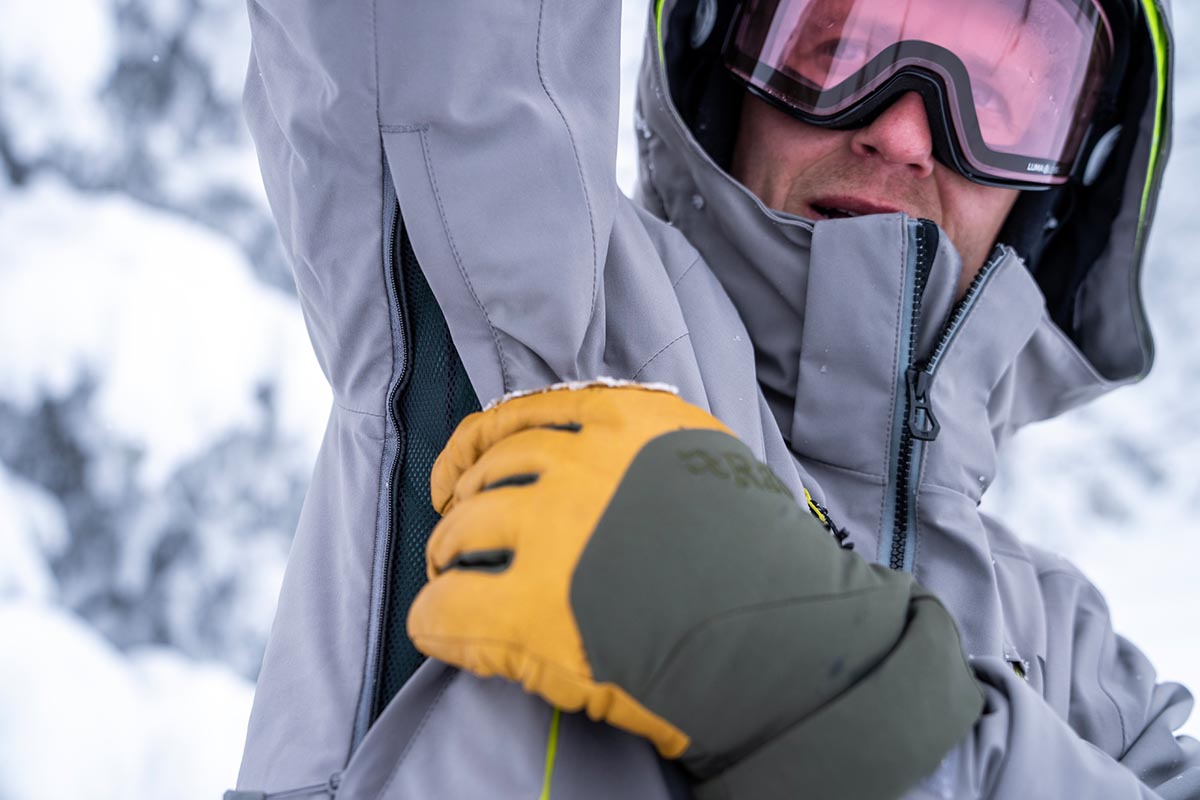
A final feature to help with breathability is the brand’s H2Flow system, which comprises two strips of mesh built into the lining along the back of the jacket. The aim is to keep air moving around your body when you open the underarm vents, and I’d say it’s largely effective. Outside of really exerting myself on a hike, I’ve been able to wear the jacket in nearly all below-freezing conditions.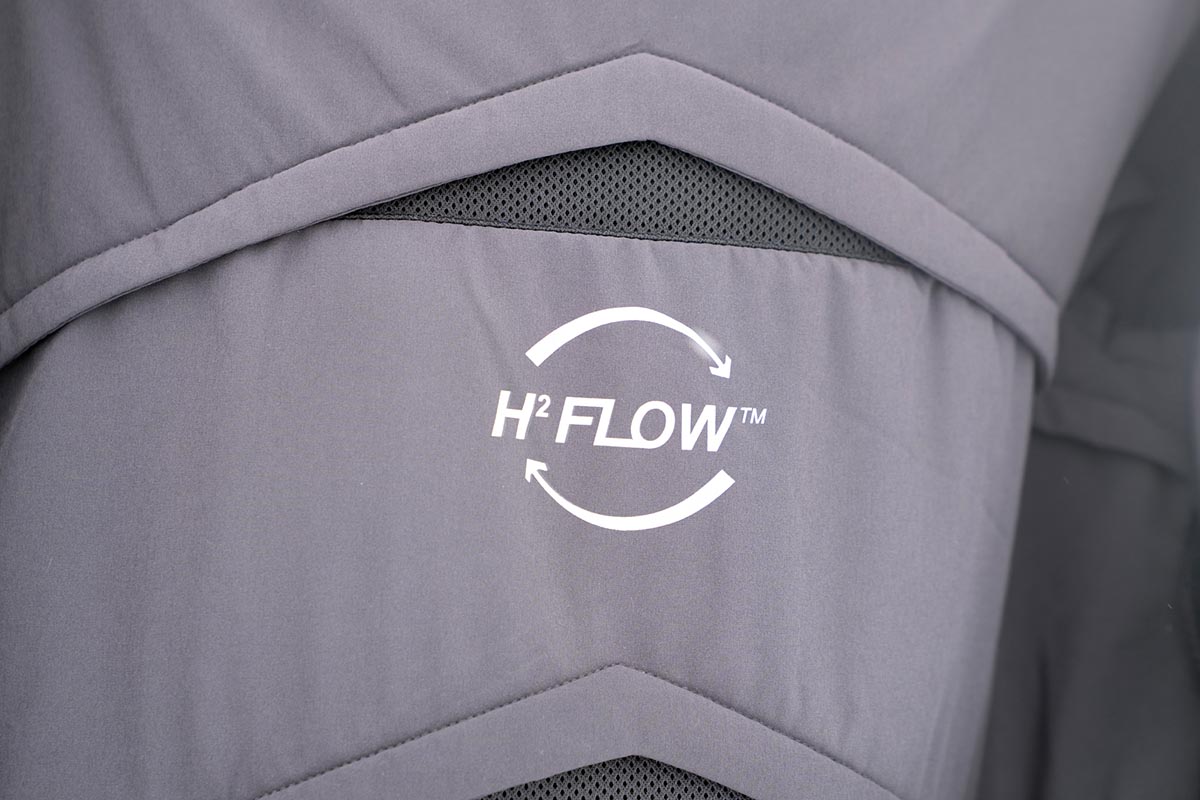
If I were to pinpoint one highlight of the Alpha 4.0’s design, it would be its fantastic comfort. There’s a lot of stretch in the construction (15% elastane in the shell and 14% in the lining), the polyester interior is extremely soft, and the athletic fit gives it a highly cozy feel. We also think Helly Hansen nailed the details: There’s a big section of fleece right at the top of the collar that wraps fully around the neck and front of the face, the hand pockets have a fleece-like material for the back of your hands, and there are stretchy gaiters built into the cuffs with openings to slide your thumb through.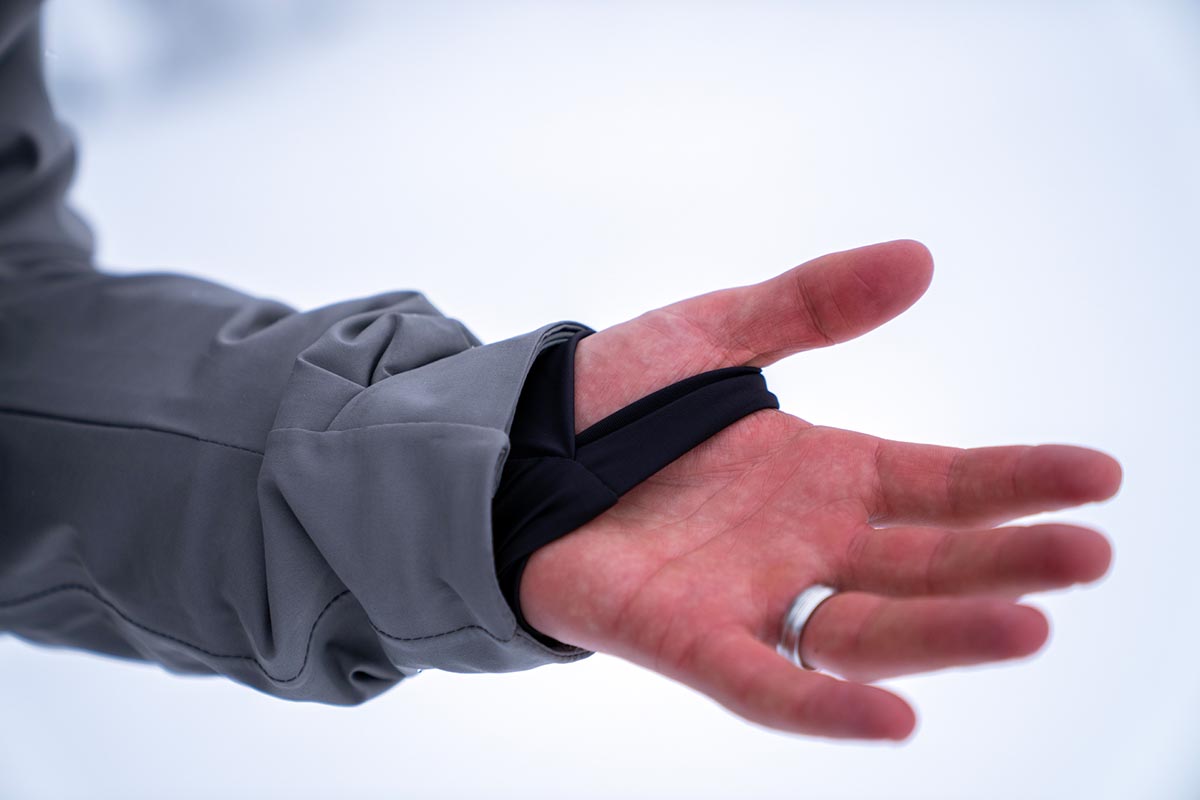
All in all, the Alpha 4.0 is an extremely cozy design that stacks up favorably with far more expensive jackets, including Arc’teryx’s premium Macai and Macai Lightweight. Considering those jackets are about twice the cost of the Alpha (the standard Macai is an eye-watering $1,100), that’s high praise for the Alpha. And like the Arc’teryx designs, the Helly Hansen crosses over really nicely for wearing around town thanks to its subdued styling, removable hood, and not-too-long cut.
It might seem like a stretch to call a $500 jacket a great value, but the Helly Hansen Alpha 4.0 offers a whole lot for avid resort skiers, even at full MSRP. The premium materials (including the highly stretchy shell and lining), feature-rich layout, and extremely comfortable design all give off a high-end look and feel. And thus far, the Alpha is holding up great: I’ve kept up on washing the jacket, so the DWR coating is still working as intended; the stretchy exterior has no tears or signs of excessive wear; and all the smaller components are still functioning like new. I’ve been particularly impressed by the quality of the zippers, which have performed flawlessly. Ski jacket zippers are notorious for being stiff and a pain to operate, but even the underarm vents are easy to use with gloves on—a very helpful trait for quick adjustments on the chairlift or when stopping mid-run.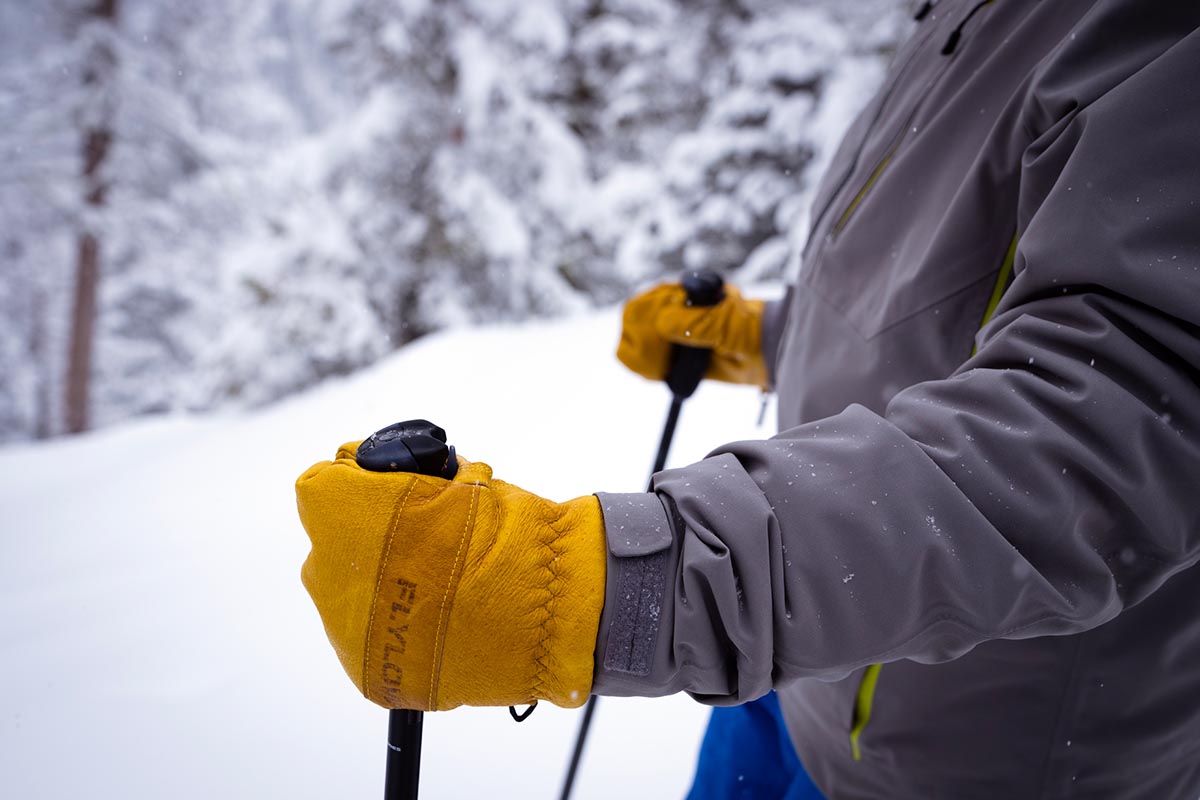
Helly Hansen doesn’t provide the fabric denier (a measurement of fabric thickness) for the Alpha’s shell, but it strikes me as roughly average and plenty tough for years-long resort and everyday use. If you’re hard on your gear and want an ultra-tough build, there are certainly burlier options out there (a Gore-Tex design like Patagonia’s Storm Shift comes to mind), but I’ve had no concerns about toughness and longevity thus far in testing. And based on our experiences with the prior two generations—our Alpha 2.0 is still holding up well—I’m confident the new model is built to last.
We typically don’t focus too much on the weight of a resort jacket, but it can be a helpful indicator of bulk and how it feels to wear all day. Our men’s medium Alpha 4.0 tipped the scale at 2 pounds 5.2 ounces (Helly Hansen lists it at 2 lb. 8.6 oz.), which is a little on the heavy end among insulated options. For comparison, the aforementioned Arc’teryx Macai weighs a bit less at 2 pounds 2.9 ounces, Trew Gear’s slightly less insulated Tatoosh is 2 pounds 5.5 ounces, and Patagonia’s popular Insulated Powder Town comes in at 1 pound 14.7 ounces. The extra weight can likely be attributed to the Alpha’s feature-rich construction and added stretch in the fabric. That being said, the listed weight doesn’t’ truly reflect how it feels, and the Alpha’s great fit means I hardly noticed it throughout full days on the hill.
Helly Hansen took a pretty comprehensive approach with the Alpha 4.0’s hood design. On one hand, it’s removable thanks to a zipper along the back of the neck and Velcro tabs built into the front of the collar. However, they also attempted to give it the full adjustability of an integrated design, with two cinches at the front and a single rear drawcord. The net result is a solid B+ effort, although there are better-fitting hoods out there if you want to really batten down the hatches.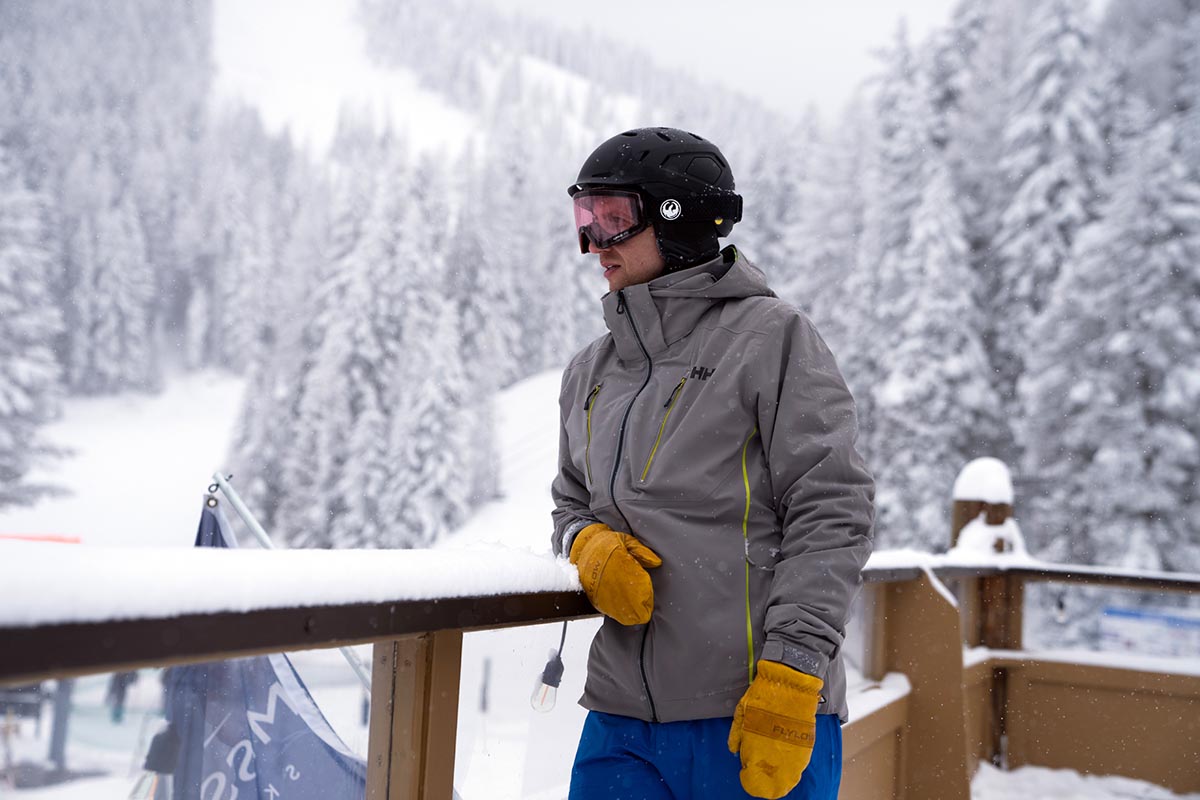
In terms of fit, the Alpha’s hood slid comfortably and without restriction over some relatively bulky helmets, including Smith’s Nexus MIPS. That said, the cinches along the sides require you to remove your gloves to adjust and lock the cords into place. The removable design also creates a wider aperture that leaves more of your face exposed (primarily the sides of your chin and cheek). Realistically, we’re nitpicking here, and it’s only a potential concern on the worst of weather days. But we do prefer the security and ease of use of a premium one-piece design like Arc’teryx’s StormHood in particularly rough conditions.
For storage, the Alpha comes nicely equipped with five pockets along the exterior. The hand pockets have a nice fleece-like lining for the back of your hands, and the chest pockets are a good size for storing electronics or a snack. The left hand pocket also has an additional layer of insulation (PrimaLoft’s low-profile Aerogel) to keep your phone’s battery from draining quickly in the cold, and the left sleeve boasts a small zippered pocket for a ski pass. Helly Hansen didn’t include any zippered storage along the interior—not a big loss in our eyes given the practical exterior layout—but there is a stretchy mesh drop-in pocket on the right side that’s plenty big for a pair of gloves or goggles. Taken together, it’s a functional layout with ample options for divvying up a phone, wallet, snacks for the day, and more.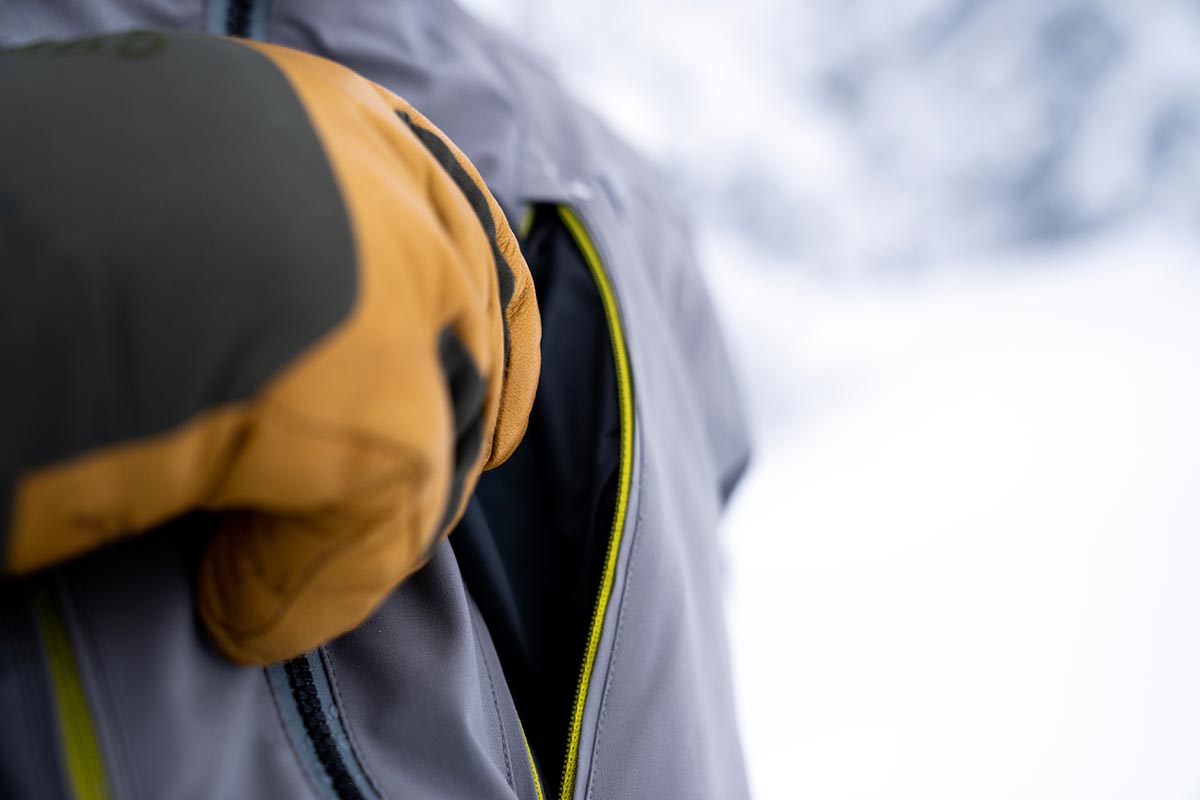
At 5’9”, 155 pounds, and with a 38-inch chest, I opted for a men’s medium in the Alpha 4.0 and found it to be just about perfect. The cut was relatively trim—a good thing as I typically only paired it with a baselayer—but there was enough room to add a lightweight midlayer on truly frigid days. And the stretchy construction meant that I never once felt any restriction while skiing, loading skis into a roof box, or bending down to adjust bindings. The sleeve length was also spot-on for me, with just enough coverage to fully protect the back of my hand (it worked great with both undercuff and gauntlet-style gloves). Finally, as I mentioned above, the cut is best described as waist-length—it provided plenty of coverage in all sorts of conditions, but if you prefer full backside protection when sitting on a lift, you may want a longer cut.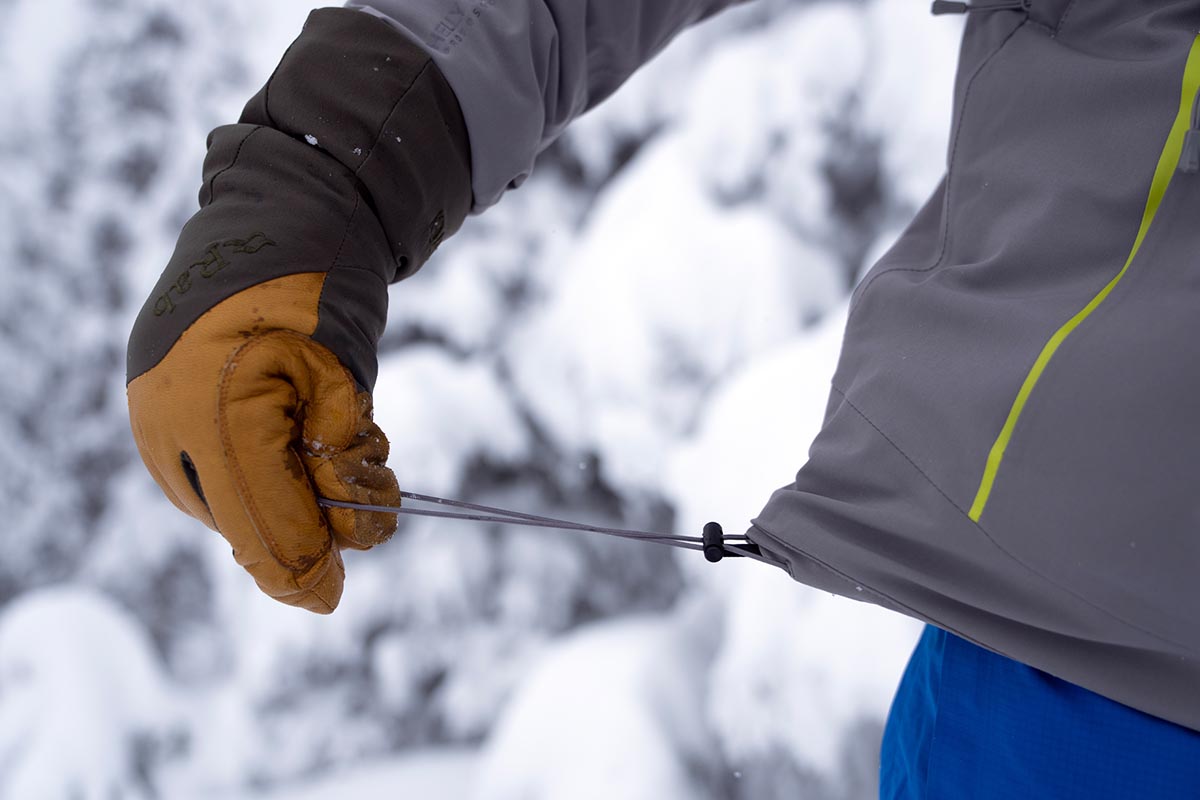
Sustainability is top of mind nowadays, and we always appreciate when brands go the extra mile toward minimizing their impact on the environment. The Alpha 4.0 Ski Jacket employs many of the key measures we look for, including a PFC-free DWR coating that forgoes the use of per- and polyfluorinated chemicals—"forever chemicals" known to be harmful to the environment—and bluesign-approved materials that have been sourced and produced to minimize their environmental impact. The polyester used in the lining is also recycled, along with the PrimaLoft Black Eco insulation, the latter of which is made primarily from plastic collected along coastlines. Taken together, it’s a comprehensive effort from the brand and only adds to the Alpha’s all-around appeal.
We put the men’s Alpha 4.0 Ski Jacket through its paces for this review, and the women’s counterpart is called the Alphelia Jacket. The two designs are largely similar, although the Alphelia uses the brand’s Helly Tech Performance membrane, which is a slight step down in all-out protection from the Alpha’s Helly Tech Performance waterproofing. The women’s jacket also forgoes the H2Flow system, although you still get pit zips for dumping excess heat. Final differences are a slightly lower weight (2 lb. 3.3 oz.) and retooled pocket layout, including just one exterior chest pocket but more interior storage. Zooming out to the wider Alpha collection, Helly Hansen also offers the upgraded Alpha LifaLoft Insulated ($550) and Alpha Infinity Insulated ($600) jackets, along with Alpha LifaLoft Insulated Ski Pants ($375) for those who want an integrated kit (the women’s collection sticks to a similar script).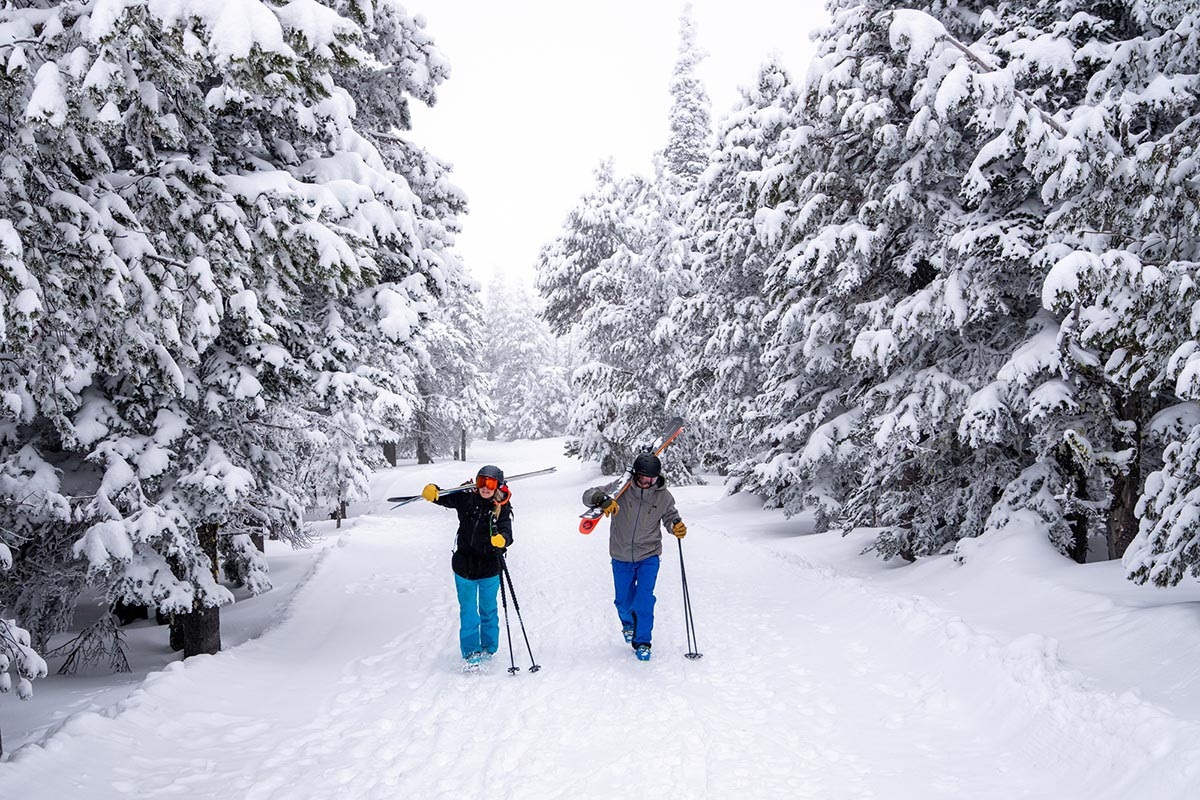
| Jacket | Price | Type | Best For | Waterproof | Insulation | Weight |
|---|---|---|---|---|---|---|
| Helly Hansen Alpha 4.0 | $475 | Insulated | Resort | 2H Helly Tech | 80g | 2 lb. 8.6 oz. |
| Patagonia Powder Town | $399 | Insulated | Resort | 2L H2No | 80g / 40g | 1 lb. 14.7 oz. |
| Outdoor Research Tungsten II | $479 | Insulated | Resort | 2L Gore-Tex | 60g / 45g | 2 lb. 0.2 oz. |
| Trew Gear Tatoosh | $349 | Insulated | Resort | 2L PNW | 60g | 2 lb. 5.5 oz. |
| Arc'teryx Macai Lightweight | $800 | Insulated | Resort | 3L Gore-Tex | 750-fill down & 60g | 1 lb. 14.2 oz. |
Helly Hansen’s Alpha 4.0 puts it all together better than most other resort ski jackets, but you can save some cash with Patagonia’s Insulated Powder Town. For around $125 less than the Alpha, the Powder Town checks in lighter at 1 pound 14.7 ounces and stacks up competitively in all-around protection with a reliable 2-layer H2No build that held up great in testing. As we’ve come to expect from Patagonia, the jacket is also sustainably built with a fully recycled shell and lining, a PFC-free DWR coating, bluesign-approved materials, and a Fair Trade certification. Where the Alpha pulls ahead is in the comfort department: The stretchy shell and soft-touch interior result in a noticeable boost in mobility and all-day coziness. That’s enough to push it ahead in our rankings, but the Insulated Powder Town nevertheless is a capable and well-built alternative for less (for more, see our in-depth Powder Town review).
Next up is Outdoor Research’s Tungsten II, which costs around the same as the Alpha 4.0 at $479. In this case, OR opted for a proven 2-layer Gore-Tex construction with light and balanced insulation (60g VerticalX Eco in the body and 45g in the sleeves and hood). You also get a practical and weather-ready feature set that includes pit zips, a brushed tricot chin guard, a two-way main zipper (which the Alpha 4.0 lacks), and a more secure hood design with a wire brim for deflecting precipitation. Added up, the Tungsten gets the advantage in all-out protection but puts less of a priority on comfort—the Alpha’s integrated stretch and nice touches like wrist gaiters make a noticeable difference in that regard.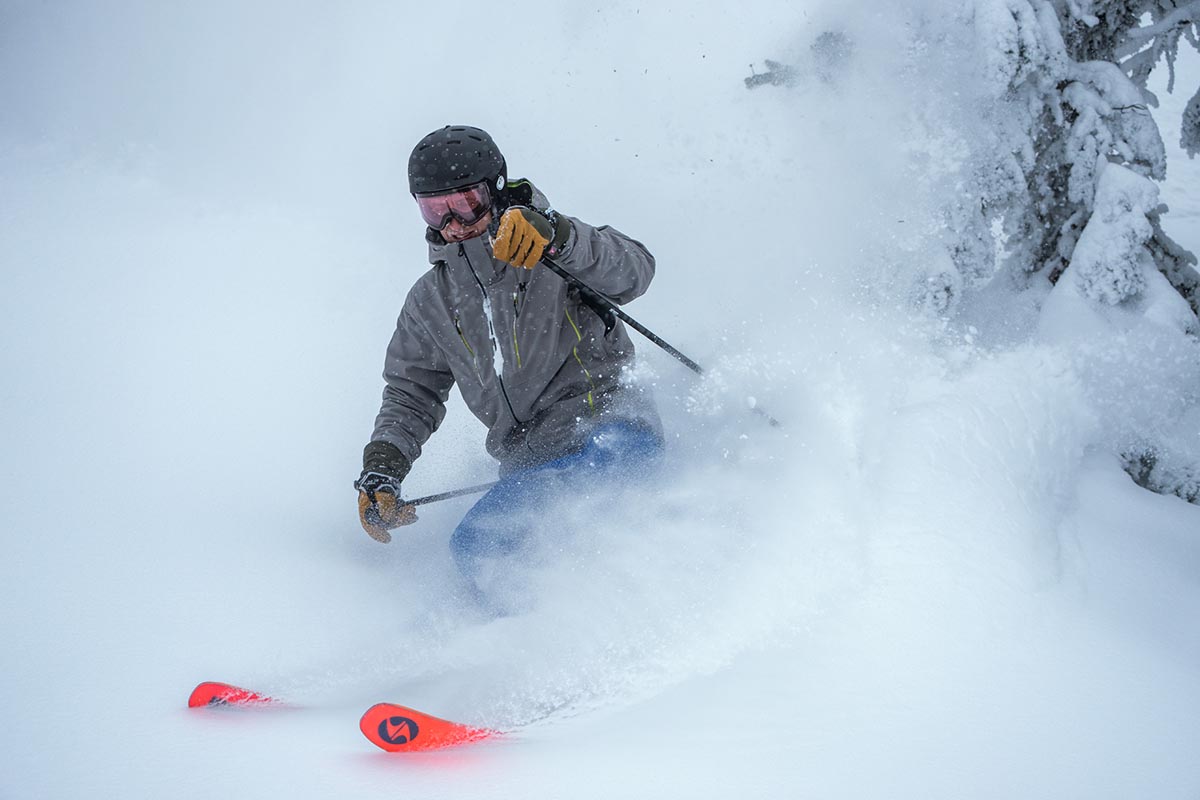
Another competitive option to have on your radar is Trew Gear’s Tatoosh, which marked their foray into the insulated resort market. As expected from the freeride specialist, the Tatoosh has a roomy, relaxed fit with excellent coverage and a burly construction that’s built to last. Storage is another selling point, including dual zippered chest pockets, zippered hand pockets, a pass pocket on the left bicep, and internal mesh drop-in pockets for stashing items like goggles and gloves. The rest of the feature set stacks up similarly well, including sizable pit zips, a helmet-compatible hood with three drawcords for adjustments, a removable powder skirt (the Alpha’s is fixed), full seam taping, and a hidden Recco reflector for transmitting your location to rescuers in the event of an emergency—all for $126 less than the Helly Hansen. That said, the Trew Gear is far bulkier-feeling and noticeably less stretchy and mobile than the Alpha, which we feel warrants the price jump, especially for committed riders who get out a lot.
A final alternative to have on your radar is Arc’teryx’s Macai Lightweight Jacket, which is their “intro” offering in the premium Macai collection. Stacked up against the Alpha 4.0, the Macai Lightweight is a little less insulated but offers comparable warmth thanks to the mix of lofty 750-fill down and synthetic insulation (60g Coreloft Compact) in moisture-prone areas. Protection and build quality are also top-notch, including a reliable Gore-Tex membrane, a thoughtful feature set, and hardwearing materials throughout. In the end, the Macai Lightweight is about as good as it gets for resort skiing, but the $325 price jump is undeniably hard to swallow. For nearly half the cost, the Alpha does a similarly great job crossing over for daily wear and is all you truly need for season-long resort use.
If you’re thinking about buying gear that we’ve reviewed on Switchback Travel, you can help support us in the process. Just click on any of the seller links above, and if you make a purchase, we receive a small percentage of the transaction. The cost of the product is the same to you but this helps us continue to test and write about outdoor gear. Thanks and we appreciate your support!
Depending on the seller, most products ship free in the United States on orders of $50 or more. International shipping availability and rates vary by seller. The pricing information on this page is updated hourly but we are not responsible for inaccuracies.